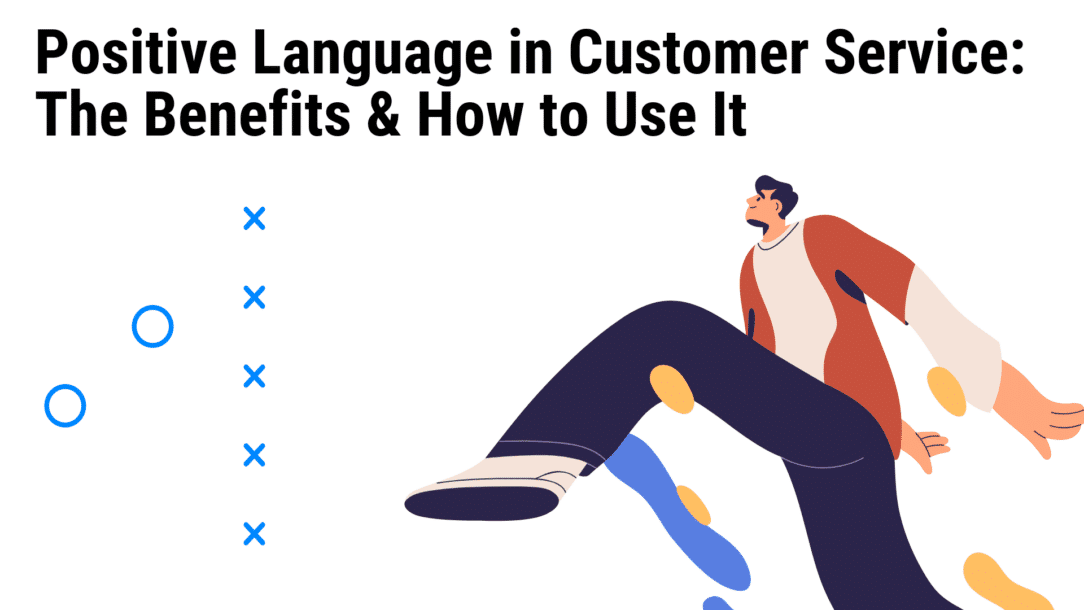Imagine this scenario: You’re at a customer service desk, and the representative is being short with you. They’re not making eye contact, they’re not smiling, and they’re giving you one-word answers. How does this make you feel? Now, imagine the same scenario, but with a different customer service representative. This time, they’re making eye contact, they’re smiling, and they’re using positive language. They might say something like, “I appreciate your patience,” or “I’m happy to help you with that.” How does this make you feel?
Chances are, the second scenario made you feel better. This is because positive language can go a long way in customer service situations. Nothing in the world matters more to a company than its customers. And nothing is more important to customer service representatives than making sure those customers are happy. This is why it’s so important to use positive language when dealing with customers.
Good customer service is the backbone of any company. After all, customers are the ones who keep businesses running. Representatives who use positive language show that they care about their customers and want to make sure they’re happy. This, in turn, makes customers more likely to do business with the company again.
So, what is positive language? In this starter guide, we will:
- Define the positive language
- Define the negative language
- The psychology of positive language in customer service
- What does negative language do in customer service
- Give examples of positive language in customer service
- Chatbots – The next step in positive language customer service
- Offer tips and secrets on how to use positive language in customer service
What is positive language?
“Positive language” is a term used to describe the act of using certain words and phrases that have a positive connotation. In other words, it’s the opposite of using negative language. When you use positive language, you’re trying to make the person you’re talking to feel good.
The Psychology Behind Positive Language
When you were a kid, your parents probably told you to use please and thank you. And they were onto something. Research shows that using words like please and thank you can actually make people more likely to comply with your requests. In one study, researchers had people ask for favors from strangers. The researchers found that the people who used words like please and thank you were more likely to have their favors granted than those who didn’t use them.
Speaking from the psychological perspective, positive words and phrases can actually change a person’s brain chemistry. They increase levels of serotonin, which is the “feel-good” chemical in the brain. This, in turn, makes the person feel happier and more positive. When a furious customer is screaming at you and demanding a refund, his or her brain is highly likely to be low on serotonin. This is why it’s so important to use positive language in these situations – you could potentially change their brain chemistry and calm them down.
Check this screenshot to know what I mean:

Uber Positive Language
Look the customer is screaming. He is so angry on Uber drive, but look at how Uber’s representative is positively handling the issue. This is why customer service representatives always smile while guiding customers on the call. The fact, that they are not in front of customers, does not matter. The moment they smile, their brain chemistry changes, and they start sounding more positive on the phone.
Check this screenshot:

Slack Positive Language
Do you see how Slack responded? The expression, Oh no! It shows, how they feel when they see the customer is not happy. It also acknowledges that something went wrong. And finally, it offers a solution to fix the problem. If a customer feels like the company cares about their problem, they’re more likely to do business with them again.
What is negative language?
Now, let’s take a look at negative language. “Negative language” is, quite simply, the opposite of positive language. It’s using words and phrases that have a negative connotation. For example, instead of saying “I’m sorry for the inconvenience,” you might say “This is not our fault, it’s a system error.” Or, instead of saying “We’ll do our best to help you,” you might say “I can’t make any promises.”
Negative language is often used without the speaker realizing it. It can be subtle, like using the word “but” instead of “and.” For example, “I’m sorry, but we don’t have any more of that product in stock.” Negative language can also be more overt and direct. For example, “I’m not sure what you want me to do about that.”
The problem with negative language is that it can make people feel worse. And when people feel worse, they’re less likely to comply with your requests. In the customer service world, this can be a major problem. If a customer feels like you don’t care about their issue, they’re less likely to do business with you again in the future.
What does negative language do in customer service?
Negative language can have a number of negative effects on customer service. First, it can make the customer feel like you don’t care about their issue. This can lead to them feeling angry and frustrated, which will only make the situation worse. Remember, a lost customer is a lost sale. And an angry customer is likely to tell other people about their bad experience, which can lead to even more lost sales.
Second, negative language can make the customer feel like you’re not competent. If you can’t even speak to them in a positive way, how can they trust you to resolve their issue?
Third, negative language can make the customer feel like they’re not valued. If you’re constantly using negative language, it sends the message that you don’t think they’re important. This can lead to them feeling unimportant and unvalued, which is the last thing you want.
So, how can you avoid using negative language in customer service?
Convert Your Negative Statements Into Positive Ones
The first step is to be aware of the negative words and phrases you’re using. Once you’re aware of them, you can start to convert them into positive statements. For example, instead of saying “I’m sorry for the inconvenience,” you can say “Thank you for your patience.”
Explanation:
The word “inconvenience” has a negative connotation. It implies that the customer is being a bother and that their issue is not a priority. The word “patience,” on the other hand, is a positive word. It implies that the customer is being understanding and that you appreciate their cooperation.
Here are some other examples of negative statements and how you can convert them into positive ones:
- Negative statement: “This is going to take a while.”
- Positive statement: “I’ll be with you shortly.”
- Negative statement: “I’m afraid but it’s the weekend so you will have to wait till Monday.”
- Positive statement: “I’ll be happy to help you as soon as possible.”
- Negative statement: “I’m sorry but you’re not eligible for a refund.”
- Positive statement: “I understand that you’re upset. Let’s see what we can do.”
- Negative statement: “That’s not my department.”
- Positive statement: “Let me transfer you to the right department, thank you for your time.”
Do you see that?
Check how each positive statement is more customer-focused and positive than the negative statement it replaces. Each one reassures the customer and makes them feel valued. And that’s exactly what you want. Every customer wants to feel like they’re important, and that you care about their issue. Nobody wants to feel like they’re a bother or that their issue is not a priority.
But Here is the Big Catch!
No matter how well you try to avoid using negative language, there will be times when it’s unavoidable. Though customer service is important, you’re only human. And sometimes, things just don’t go the way you want them to. This is why chatbots have become the new trend in customer service.
How Chatbot Can Help You Deliver Positive Language in Customer Service?
AI chatbots are designed to handle customer service issues without the need for human intervention. This means that they can provide a positive, seamless customer service experience, even when things go wrong. Plus, chatbots can be programmed to avoid using negative language. This means that they can provide a positive customer service experience, even when you’re not able to. No matter what the situation is, your chatbot will be able to provide a positive customer service experience.
You can train your chatbot to handle customer service issues in a positive way. Imagine chatbot deals with a furious customer while you focus on other aspects of the business. The customer is angry and wants to speak to a human. But instead of getting frustrated, the chatbot calmly diffuses the situation and provides a positive customer service experience.
Additional Tips and Secrets for Positive Language in Customer Service
Chatbots are the sure-shot way of delivering positive customer service. But if you’re not ready to invest in a chatbot just yet, here are some additional tips and secrets for delivering positive customer service:
1) Listen, Listen, Listen!
Psychology says that when we listen, we feel more valued. When you give your customers your undivided attention, it makes them feel appreciated. And when they feel appreciated, they’re more likely to have a positive attitude towards you and your company. Imagine a customer is telling you about their problem. They’re getting frustrated because they feel like your brand doesn’t care about them. But when you give them your undivided attention and listen to their problem, it shows that you care. And this makes them more likely to have a positive attitude towards you.
2) Repeat Their Name
“Thank you for calling, _______. How may I help you today?”
When you repeat a customer’s name, it makes them feel special and appreciated. It also makes them more likely to trust you and do business with you. Remember, people like to do business with those they know and trust. When you use a customer’s name, it helps to build that relationship.
3) Use “We” Statements:
When communicating with a customer, using “we” statements can help to create a sense of partnership or team. For example, instead of saying “I can’t help you with that,” try “Let’s see what we can do to solve this problem together.” This type of language conveys that you are on the customer’s side and that you are working together to find a solution. When you use the word “we” instead of “I”, it shows that you’re part of a team. And when you’re part of a team, it shows that you’re working together to solve the customer’s problem. This makes the customer feel like they’re not just a number, but an important part of your team.
4) Avoid “But”
The word “but” has a negative connotation and can immediately negate anything that came before it. For example, saying “I’m sorry, but we’re out of that product” sounds a lot better than “I’m sorry, but you’ll have to order it online.” You can replace “but” with phrases like “however,” “yet,” or “nonetheless.” The idea is to sound positive and helpful, rather than negative and unhelpful.
5) Focus on Problem, Not Person:
Language is a powerful tool that can help to diffuse a tense or difficult situation. When speaking with an upset customer, it’s important to use language that doesn’t place blame on the customer or make them feel like they are being attacked. For example, instead of saying “You didn’t fill out the form correctly,” try “Let’s take a look at the form together and see where the problem is.” This type of language keeps the focus on the problem, not the person, and can help to de-escalate a situation.
6) Speak Loudly – But Not Too Loudly:
In some customer service situations, it may be necessary to speak loudly in order to be heard. However, speaking too loudly can come across as aggressive or confrontational. It’s important to find a balance – speak loudly enough to be heard, but not so loudly that you come across as angry or hostile. Albert Mehrabian, a UCLA professor says, 30% of the communication depends on the words we use and the tone of voice. Therefore, it’s important to focus not just on the words we use, but also on the tone of voice. The way we say something can be just as important – if not more important – than the actual words we use.
7) Make Suggestions Instead of Demands:
When making requests of customers, it’s important to use language that is respectful and polite. For example, instead of saying “You need to fill out this form,” try “Can you please fill out this form?” or “Would you be able to fill out this form?” This type of language is more likely to result in a positive response from the customer. Always remember, customers, are more likely to comply with requests if they feel like they are being treated with respect.
8) Keep it Personal, not Professional:
Now, this is important. In customer service, it’s important to remember that customers want to deal with people, not faceless corporations. Therefore, it’s important to use language that is personal and friendly. For example, instead of saying “Our company policy is…” try “I can understand why you’re feeling frustrated. Let me see what I can do to help you.” This type of language will make the customer feel like they are dealing with a human being, not a faceless entity.
If your customer representative deals with customers as customers, not as human beings, they will never build a good rapport with them. And in today,s competitive world, good rapport is very important to keep the customer happy. These are some of the most important points to keep in mind while using positive language in customer service. Remember, the words you use can have a big impact on the way customers perceive your company. So choose your words carefully and always keep the customer’s best interests in mind.
Conclusion
2022 has been the year of chatbots. AI is ruling the market. Thousands if not millions of chatbots are being used in customer service. The main aim of these chatbots is to provide 24/7 support to the customers and to save human resources. However, if you are still on the fence about using a chatbot or you think your industry is not suited for it, you can always give positive language a try. After all, it costs nothing and the benefits are plenty.
Encouraging positive language and avoiding negative language is important in customer service for a variety of reasons. Positivity can help to build rapport, diffuse difficult situations, and make customers feel more comfortable. Ultimately, using positive language is a key part of providing excellent customer service. When it comes to customer service, always remember: the customer is always right. Even if they’re not, it’s important to remember that the customer is always the priority. So choose your words carefully and always keep the customer’s best interests in mind.
Related Posts



